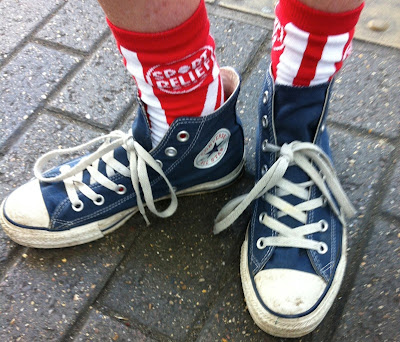The idea of being awakened to trends, as though knowing what's going to happen allows you to instantly exploit your marvellous insight, is always very appealing. But actually the point of trends is that they are happening, and things you notice happening to yourself are often because you are indeed in the midst of, or at the the start of, a trend. Trends are not predictions. Trends are happening now, and often continue for quite some time, and continue to build in the public sphere well after they've been spotted. Here's a few of my own observations (rather than the ones gleaned from trendspotting sellers...):
Interventionist practices are gaining in popularity
I didn't know what this meant either, but having been enrolled to help my son write an essay entitled "The role of participation in interventionist practices" I am now a bit wiser. Just think Occupy, and then Arab Spring. These are the broad brush illustrations of what's going on closer to home. My two examples are the
Seedbombfactory starter kit I saw at
home this week. An invitation to become a Guerrilla gardener. Which I love. Secondly, my discovery of
PARK(ing) Day, which I am seriously considering participating in this September 21st. Watch this space.
British heritage with a twist
This one has been lurking up for a while, but like many good trends carries on getting bigger after you think it's done and dusted.
Alexander McQueen have always been masters of this,
Vivienne Westward is of course Grand High Witch of the dark magic and indeed even the likes of
Boden play at it. The ones we've spotted lately are
Grensons. Having been bought by Tim Little in 2010, an ex-advertising chap who set up his own shoe label in 1997, he is now CEO and Creative Director and injecting a certain flair into the product line. Heritage is having its moment in the fashion limelight, and, as Tim says, on
LDN fashion, '
Heritage has always been important as it means authenticity. Recently it has become a fashionable word but really all it means is that “these people must know how to make a decent product as they have been doing it for a long time'. What starts making it cool is his eye for detail and the mixing of traditional materials like
British Millerain wax cotton and soft Italian calf leather on the
Glenn Military Boot.
Made in Britain
Not dissimilar to the trend above, but a more general pride in hand-made and British-made. Inspired by the economic downturn, everyone wants (for some of the time) to support British makers, tap into a little bit of 'post-war' patriotic warmth, buy things that have value beyond 'instant gratification' and feel part of a growing wave of artisanal products offering quality, taste and individuality. As Jane Parker writes in her article on
The Foodie Bugle about
Starch Green,
'Their website and blog are the apogees of that quiet, stylish, simple genre of "Made in Britain" arts and crafts for which the nation is increasingly gaining global recognition.'
i-connected machines
That sci-fi idea of machines that talk to each other and do everything for you - not so far away apparently. I remember, whilst working at
BT in 1996 or so, talking about the increase in the amount of 'information' every individual would soon be receiving in 5/10/15 years, being quoted the likes of doubling every year, month, minute... We had no idea what we were talking about. Internet was essentially dial in, websites were in their infancy, no google, no Facebook, no twitter, no youtube. Now almost every piece of technology I deal with daily talks to each other.
iCloud has enabled my phone to synchronise with my MacBook Pro and in turn my iPad. My diary synchronises with my colleagues' wherever they are, my email is available on all my devices - look no wires. The future sneaks up on you and you're living it - you don't need to know how. I received an email from a friend last night that signed off, 'sent from my dishwasher'.
Hockney-itis
The trend here, apart from everything now looking like 'Hockney trees' or 'Hockney iPad drawings', is art you can look at, enjoy and understand. It's about looking, drawing and painting. It affects you emotionally, viscerally. On the wave of illustration that has been growing over the last few years with the likes
Rob Ryan,
Jonny Hannah,
Mark Hearld and
Emily Sutton, ably fanfared by, for example,
St Judes,
Mainstone Press and
Webb and Webb, figurative imagery is fast gaining traction. David Hockney's eye for colour, his draughtsmanship, obsession and prolificness is inspiring, breathtaking and, most significantly in this context, influential. Get down to David Hockney: The Bigger Picture at
RA as soon as you can. And don't be surprised if you break out in Hirst-pox, too. Every
Gagosian is full of every Hirst spot painting for the next month, as is the window of
Uniqulo. More Hirst at
Tate Modern from April.















